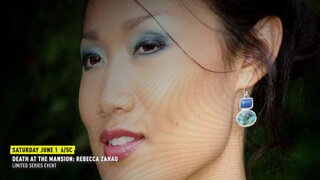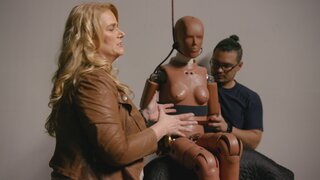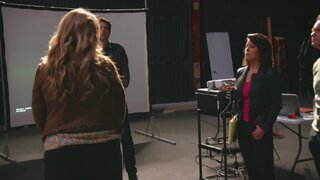Create a free profile to get unlimited access to exclusive videos, breaking news, sweepstakes, and more!
Expert Witness Believes Rebecca Zahau Was Sexually Assaulted Despite Official Findings
The San Diego Sheriff’s Department and Medical Examiner’s Office found no evidence of sexual assault when investigating Rebecca Zahau’s death.
Authorities ruled that Rebecca Zahau’s death was a suicide. Authorities found the 32-year-old naked and and bound with rope at the Spreckels Mansion, where her boyfriend, multi-millionaire Jonah Shacknai, lived. Jonah’s brother, Adam, was staying in the guest house at the time, and called 911, saying he found Zahau hanging and cut her down.
San Diego County Sheriff’s Department investigators reviewed the case with other agencies in 2018, after a civil jury found Adam Shacknai liable for Zahau’s death.
Adam has denied any responsibility, and told news outlets the civil case was settled by his insurance company without his knowledge.
Investigators who took part in the review maintained that they believed Zahau’s death was suicide. However, family members, like Zahau’s sister Mary, believe she did not take her own life.
The manner and cause of death was not the only issue on which sheriff’s department investigators and the Zahau family’s attorney, Keith Greer, disagreed. Investigators and the medical examiner also ruled there was no evidence Rebecca was sexually assaulted. However, Greer argued that the civil trial evidence pointed to Rebecca being sexually assaulted with a knife handle found at the scene.
In “Death at the Mansion: Rebecca Zahau,” airing on Oxygen, former Los Angeles prosecutor Loni Coombs looked into Rebecca’s death with investigative journalist Billy Jensen and retired cold case investigator Paul Holes. Coombs spoke with Greer during the final episode of the series. He said the case had the appearance of sexual crime from the beginning.
“Beautiful woman, naked, bound, gagged, hands tied behind her back, hung off in this very demeaning manner, but then the sexual assault became apparent,” Greer said.
At the civil trial, forensic specialist Lisa DiMeo, formerly of the San Diego Sheriff’s Department, was called by Greer. DiMeo testified that Zahau’s menstrual blood was on all four sides of the knife handle that was found at the scene.
Greer alleged at the civil trial that the blood being on all four sides of the handle indicated a sexual assault.
“The only source would’ve been if she was sexually assaulted, because it was menstrual fluid,” Greer said.
Defense witness Denys Williams, a former lead forensic evidence technician for the San Diego Sheriff’s Department crime lab, testified that she took pictures of Rebecca’s body at the scene. When asked by Adam’s defense team if she recalled any specific injuries to Rebecca’s body, she said the most obvious one was on Rebecca’s finger.
Williams testified that she believed the blood on the bottom rivets of the knife came from the injury on Rebecca’s hand, according to court transcripts.
“I believed it would explain why there was a red stain on the knife, because it was still oozing at the time I was taking this photo,” Williams said at the civil trial. “There was still oozing, you know, blood out of the injury.”
Greer disagreed with Williams’ assessment in "Death at the Mansion," describing the hand wound as a rope burn that was “dry.”
Greer asked Williams to demonstrate to the jury how the blood would’ve been transferred from Rebecca’s finger to the knife handle, during cross-examination at the civil trial.
“She takes the knife and puts it through these fingers and holds the handle through those fingers, and then she’d have to rotate it around and basically intentionally try and smear the knife — and the jury just shaking their head,” Greer said to Coombs.
Greer told Coombs, Jensen and Holes that he thinks the strongest evidence presented at the civil trial was of the alleged sexual assault.
Greer used a mannequin resembling Rebecca’s build and features at the civil trial. He said during the series that he had a forensic pathologist transfer marks found on Rebecca’s body, seen in autopsy photos, onto the mannequin.
Greer said that he found black paint found on Rebecca’s nipples to be significant because he believed it appeared the paint indicated her breasts were pinched in specific areas.
“If she was the one who pinched her own nipples she would have evidence of paint on her fingers, but if you look at the fingers, there’s no paint on the inside, where you would be pinching and tweaking and touching things on the right hand or on the left hand,” Greer said.
Jensen asked Greer about the significance of blood on the inner thigh of the mannequin.
“That is a transfer mark from the sexual assault,” Greer said. “And you can see how the imprint is the size of the knife.”
Lisa DiMeo testified at the civil trial that, in her opinion, the mark on Rebecca’s inner thigh was a transfer stain from a sexual assault with the knife handle, according to court transcripts.
Rich Williams, of the sheriff’s department homicide unit, reviewed the case with other agencies, following the civil trial. At a 2018 news conference, Williams said that no evidence of a sexual assault was found in either autopsy.
The San Diego County Medical Examiner’s office said in a presentation from July 2011 that their findings indicated “no evidence of a struggle or a sexual assault and no other significant injuries.”
In 2018, the Chief Medical Examiner of San Diego County said in a statement, “The San Diego County Medical Examiner’s Department has concluded that the initial investigative findings are well documented and correctly interpreted. The cause and manner of death in Rebecca Zahau’s case remains unchanged.”
Attorneys for Adam Shacknai said during closing arguments at the civil trial that no evidence or testimony connected Adam to Rebecca’s death. Adam has maintained his innocence.
To learn more about the case, watch “Death at the Mansion: Rebecca Zahau” on Oxygen or the Oxygen app.






























